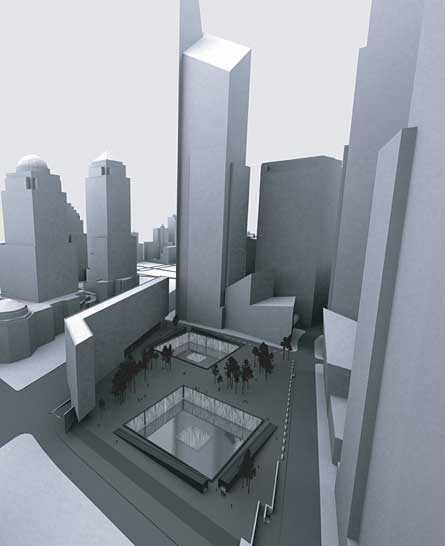| Reflecting
Absence
By Michael Arad

Click these thumbnails for enlarged views of the Reflecting
Absence proposal.
• • • • • • • • • • • • • • •
TThis design,
the only one that eliminates Daniel Libeskind’s cultural
center from the memorial site, centers around two pools,
one for each of the fallen twin towers. Surrounding each
pool is an underground space with glass walls allowing
visitors to look out into the pools. Into the wall, the
names of the victims are inscribed in a random order,
and water falls down the glass. The center of each pool
is at a separate, lower level.
The two pools are connected
by pathways to an underground room where visitors can
light a candle. Connected to this room is a chamber where
unidentified remains are buried, accessible only to the
family members of the victims.
Michael Arad grew up in Israel,
Mexico, and the United States. He moved to New York in
1999 and works for the design department of the city’s Housing
Authority.
• • • • • • • • • • • • • • •
Finalist Statement
"This design proposes a space that resonates with the feelings of loss
and absence that were generated by the death and destruction
at the World Trade Center. A pair of reflective pools marks
the location of the towers'
footprints. The surface of these pools is broken by large
voids. These voids can be read as containers of loss, being
close-by yet inaccessible.
The pools are submerged thirty feet below street level
in
the middle of a large open plaza. They too are large voids,
open and visible reminders of the absence. The pools are
fed by a constant stream
of water, cascading down the walls which enclose them.
Bordering each pool is a pair of sloped buildings. These
buildings create a sense
of
enclosure, capturing the exposed outer corners of the memorial
site and defining a path of circulation around each pool.
They also guide visitors
to the site into the memorial itself.
Visitors begin their
descent into the memorial by entering one of these buildings.
This descent removes them from
the sights and sounds of the city and immerses them in
a cool darkness. As they gradually
proceed, step by step, the sound of water falling grows
louder, and more daylight filters in from below. At the
bottom of their descent, they
find themselves behind a thin curtain of water, staring
out at an enormous pool that flows endlessly towards
a central void that remains empty.
A ribbon of names surrounds this pool and the enormity
of this space and the multitude of names lining it underscore
the vast scope of the
tragedy that took place at this site. Standing there
at the water's edge, looking at a pool of water that is flowing
away into an abyss, a visitor
to the site can sense that what is beyond this curtain
of water and ribbon of names is inaccessible.
The names
of the deceased appear to be in no discernible order. The
apparent randomness reflects the haphazard
brutality of the deaths and allows for flexibility
in the placement of names
of friends
and relatives in ways that permit for meaningful adjacencies;
for example, siblings who perished together at the
site could have their names listed
side by side. Family members seeking out the name of
a loved one are guided by on-site staff or a printed
directory to their
specific location.
The location of the name marks a spot that is their
own.
In between the two pools is a short passageway that
links them at this subterranean level. At its center
is a small alcove where visitors can light a candle. Across
from it, a long corridor leads to
a chamber that houses unidentified remains. This
space is only open to family members and serves as a private
contemplative space.
The end of a visit to the memorial
is marked by an ascent back to street level. Visitors are
again ensconced by darkness, but now the long and narrow
passageway leads
up towards daylight. As
they emerge
from the ramped enclosure, they find themselves
back in the open plaza.
The western edge of the plaza is
bounded by a cultural building that shelters the site from
the highway. The remaining three sides are
open and link the plaza to adjacent streets and
neighborhoods. Tall pines punctuate the plaza's
surface, softening
its character and creating shaded
areas within this large outdoor room. Designed
to
be a mediating space, the plaza belongs both
to the city and to the memorial.
It encourages
uses that are both contemplative and everyday.
It is a living part of the city."
Back to the main page
|